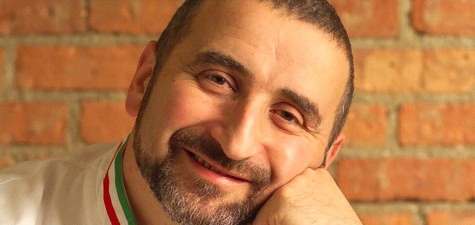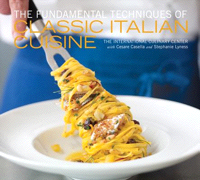
There comes a time in every cooks life when you’ll need the bible of cuisine – one of those large encyclopedic books that tell you everything you’ll ever want to know about cakes, chocolate, Greek, or Italian. The Fundamental Techniques of Classic Italian Cuisine from The International Culinary Center with Cesare Casella and Stephanie Lyness (Abrams 2012) is just such a book. Birthday present? Wedding present. Or thoughtful weekend gift, it is Serious, beautiful, and eminently useful. It is a guide, a history, and a cookbook all in one. It would be a waste to leave it on the coffee table – though it could easily entertain guests while you are whipping up antipasti in the kitchen.
 The Antipasti chapter begins the book with a discussion on current eating trends in Italy – where antipasti can make up a meal. There are many informative sidebars sprinkled throughout the chapter including one on Bruschetta, Crostini, and Fettunta:
The Antipasti chapter begins the book with a discussion on current eating trends in Italy – where antipasti can make up a meal. There are many informative sidebars sprinkled throughout the chapter including one on Bruschetta, Crostini, and Fettunta:
Fettunta: Their name is derived from the Italian words fetta meaning, “slice” and unta meaning “greasy.” Fettunta are thick slices of Tuscan bread, similar to what you’d use for bruschetta, grilled and rubbed with a garlic clove cut in half, drizzled generously with olive oil, and seasoned with salt and pepper. Fettunta are most frequently associated with Tuscan cuisine. (p. 40)
The chapter includes introductions to specific regions like Valle d’Aosta (p. 41). There are recipes for Verdure Sotto’Olio or vegetables layered with seasonings in Olive Oil – perfect for starting a Mediterranean diet! Caponata, sweet and sour eggplant (p. 47) has a long list of ingredients that includes vinegar, thyme, and capers, as well as raisins, and black olives. There is a marvelous photograph by Matthew Septimus of an octopus terrine, Soppresseta di Polpo (pp. 48-9) as well as Insalata di Mare or seafood salad, topped by curling octopus tentacles (p. 54-5) that transport one to a seaside town anywhere along the coasts.
The Fundamental Techniques of Italian Cuisine also includes lessons for the professional Italian kitchen – everything from knife choices to chapters on Working with Vegetables (p. 347) and Working with Pasta (p. 366). This part of the book includes step-by-step photos for making the recipes, breaking down a side of beef, filleting a fish, or making Cannoli Shells. It’s useful information for all kinds of cuisine. The authors are clear and easy to follow. Whether you are working with kids who want to know the “whys” and “hows” of cooking, or filling in gaps in your own knowledge and skills, this part of the book is fascinating and useful.
The Fundamental Techniques of Italian Cuisine should be on every serious cook’s shelf – whether they are cooking Italian, French, or Turkish cuisine. It will add clarity and competence.
